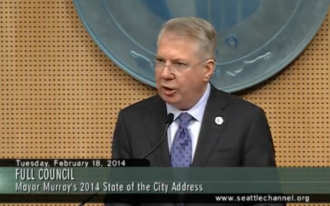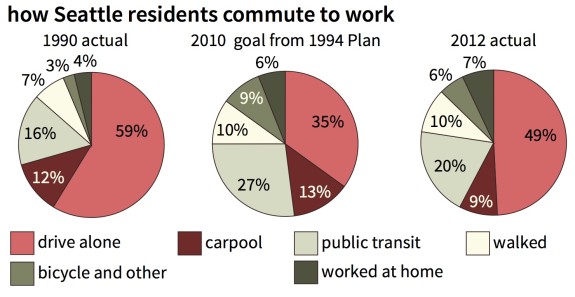 Mayor Ed Murray gave his first State of the City speech Tuesday in the City Council chambers, and he used the spotlight to announce progress on launching a public bike share system and cutting the current drive-alone commute rate in half.
Mayor Ed Murray gave his first State of the City speech Tuesday in the City Council chambers, and he used the spotlight to announce progress on launching a public bike share system and cutting the current drive-alone commute rate in half.
“Seattle is one of only five cities where less than half of commuters are in single occupancy vehicles,” he said. Noting that “nearly half of our region’s carbon emissions come from transportation-related sources,” Murray said continuing to reduce the drive-alone commute rate “will have significant impact on our overall efforts to reduce climate change.”
His goal: 25 percent of Seattle residents driving alone to work.
To get there, Murray mentioned expanding the streetcar network, saving Metro funding, passing the Bike Master Plan (which he recently helped get back on track) and launching a bike share system.
“I will announce later this month, with some of our friends at Puget Sound Bike Share, an exciting new bike share program, with funding,” Murray said. “And it appears it will be the only one launched in 2014 in North America.”
We reported previously on troubles at Bixi, the Montreal-based company that supplies the bikes and docks Puget Sound Bike Share had hoped to use. Portland, Vancouver BC and Seattle were all slated to launch systems in 2014, but the supplier troubles have caused uncertainty and likely delays.
UPDATE: It’s not clear if Seattle will actually be the only system launched in North America this year. Systems continue to proliferate around the nation, including systems in Pheonix, Milwaukee, Philadelphia and others. Vancouver and Portland also appear to still be aiming for 2014 launches.
PSBS Director Holly Houser is currently in Montreal, and we should have more bike share updates soon.
Supporting more transportation choices in Seattle will certainly help people find better alternatives to driving alone, but what will it take to reach Murray’s 25 percent goal? A recent report from the city’s Comprehensive Plan update team shows that it took 20 years to go from 59 percent of Seattle residents driving alone to work down to 49 percent. Our goal in a 1994 plan was 35 percent by 2010 (hat tip to Matt Loar):
 Getting down to 25 percent is going to take aggressive increases in job and housing density (more jobs near homes, and more homes near jobs), expansion of transit system capacity and frequency, improvements to walkability and, of course, investments in comfortable and connected bicycle routes.
Getting down to 25 percent is going to take aggressive increases in job and housing density (more jobs near homes, and more homes near jobs), expansion of transit system capacity and frequency, improvements to walkability and, of course, investments in comfortable and connected bicycle routes.
“This spring we will engage in a citywide conversation about what Seattle wants from the department,” he said, noting that he hopes to “modernize” SDOT. He reiterated his campaign platform to create a “Move Seattle Plan” that “integrates plans for bikes, for freight, for cars, for transit, and for pedestrians.”
Mayor Murray’s 25 percent goal is exciting, but of course the real challenge will be finding permanent and significant funding for these needs. It will also involve making politically-challenging changes to our city’s streets. He is off to a great start with the Westlake agreement, but there’s a lot of work left to do.
You can watch video of his full speech below (transportation comes up at the 20:00 mark):








Comments
18 responses to “Murray announces 2014 bike share launch, aims to reduce drive-alone commute rate to 25%”
Well, kudos to Murray for tackling bike issues along with transit. That goal is certainly ambitious, but with the numbers I’ve seen of shifting youth priorities, we may be in for a sea change… (& speaking of sea change, yow! I haven’t seen the whole address, but did he tackle sea level rise as the 2035 report does?)
I would like to see the actual commute numbers along with the percentages, as our population has risen significantly since 1990, and I’d be interested to see how many we are actually accommodating, number-wise.
Its interesting to see that carpooling went down. Its not surprising though as it really only works well when you live near a co-worker and both have a fairly long commute.
We do have some big employers (Boeing/Microsoft/Amazon), but we also seem to be getting a lot more medium sized employers throughout the region. This includes the satellite campuses of well known California tech giants.
My guess is that though some of those car-poolers reverted to SOV drivers, a significant chunk turned into transit riders. As the transit system gets better, I think more folks will move to that pool than any other.
Bike commuting is still strong, but I suspect it will serve an even greater role in replacing many of the frequent local trips that happen outside of commute peak by car now and to cover the first/last mile to the transit station.
I can’t imagine standard carpooling, but the flexibility of a bike makes it a more flexible option. My wife bikes to work on a folding bike, and then carpools/vanpools back home depending upon when people are leaving. If someone’s leaving at a convenient time but they don’t live close by, she can ride with them to their house and bike the remaining few miles home. Carpool/vanpool options with bike racks would make this possible with a non-folding bike.
According to press reports now a couple of weeks old, Alta has now partnered with 8D, the company that made the original software used and then rather abruptly and mysteriously dropped by Bixi.
Murray’s implied claim that neither Vancouver nor Portland will roll out a bikeshare program this year is new information- Vancouver city officials are still talking 2014.
Yeah, I updated the story calling into question Murray’s claim Seattle would be the only city in north america to launch a system. Many cities have plans to launch systems (many using other companies’ bikes), and I sure hope they don’t all get delayed.
Here’s a chart with some numbers:
http://commuteseattle.com/wp-content/uploads/2013/02/2012-Modesplit-Final-Report.pdf
Which if I read page 7 correctly says 32.7% are SOV commuters. (So where did you get your chart numbers???)
for back of an envelop calculations we can use a rough 200K people working in the city center (I assume that’s the group that Mayor Murray is talking about.)
So to go from 65K SOV driving to 50K driving, lets assume we can double the number of bicycles (although I’d like to see even more, Portland is only at 7% so we aren’t likely to beat that very quickly, so 6.6%… or 13.2K ride bikes (or 6.6K move from cars to bicycles) So we only have to increase the bus/Train group by 8.4K, which goes from 71.4K to 79.8K or an 11% growth. That’s well within the posibility of reasonable given some new taxes to run those buses and the Light Rail from Northgate.
Note: Car pools are very fuel effiecent as there is no “empty back to the base” trip that a bus has. So I wouldn’t work at getting rid of them.
So how reasonable is it to get to 6.6% bicycling to work?
Well from that same report page 16: We see that the average distance to ride is about 6 miles. So if assume that most our group of curernt 3.3% riders is in those two groups of 5 miles or less and 5 to 9 miles, we get (22.5% + 26.1% or 43% of all commuters are within 9 miles, or 86K, of which 6.6K are bike riders or 7%, so we’d need to get the close in bike commute rate up to 15%… that might be harder than it sounds given that we are already at the Portland bikeing rate of 7% (for those who think they live close enough to bike.)
But it does show that we should focus on that last mile, or closest 6 miles of the city center to get our best results. As even if we have a wonderful trail to Kenmore, or Kent or Skyway, people chose to bike if it’s “close enough”. Probably a function of lack of showers at work, a close in ride you don’t break a sweat, and time to ride, as it’s slower unless the traffic is really jammed.
Are the statistics based on literally trips to work, or is it a mixture of trips to work and trips back home from work? I’m asking because many people (including myself) are more likely to put a bike on the bus in the morning and pedal home in the afternoon, then the other way around (due to not needing to worry about showering, etc.). If you think about it this way, maybe the bike modeshare is actually a little bit better than the stats would make it out to be.
The doc you linked to with the 32.7% SOV rate is downtown only. The 50% number is city-wide.
Well, outside of the core city, it’s much harder to commute via bus unless you also are on a route that is going to the center of the city.
And outside of the core, parking is cheaper, easier etc, AND traffic isn’t as bad so there are a lot of reasons why SOV driving makes sense. (and why people do it.)
So to get those numbers at 25% we are either going to have to expand the biking with loads of greenbelts so you can easily commute from one outer area to another, AND raise parking rates in the outer areas (listen to the voters scream), OR make the core a lot easier to commute to so that we get most of the improvement from those folks.
Either way it’s going to be tough.
A metro carbon tax might help though.
Also, the 32.7% refers to downtown workers, regardless of where they live. The Comprehensive Plan numbers are for residents.
I think you are on the right track Gary. Copenhagen made it more expensive to enter the city core with added taxes and fees to make it all work. For people living in the core, the developers should be required to provide secure bicycle parking as well. Copenhagen’s bicycle parking has gotten way out of hand when you have to spend a lot of time just finding your bike. Abandoned bicycles are everywhere in their core. Seattle can learn from these issues.
I am glad to see that Seattle can still lead the country in announcing ambitious plans without a plan for achieving them.
Low-hanging fruit: connect the Burke-Gilman Trail to downtown. Totally bizarre to have a world-class multi-use path that just dies a mere 2 miles from the Seattle Center. If we could make it safe for normal people to get between the ship canal and downtown, we would unleash some huge potential. My fiancee will bike any distance in any weather, day or night, on the BG, but venturing south of the Fremont Bridge terrifies her. I don’t blame her.
Jeff, you are welcome to join the Westlake protected bike lane team that hopes to correct your issue.
[…] Bike share on the way to Seattle. […]
[…] “I made one call, and they said, let us know how to do it,” said Mayor Ed Murray of his role in helping to find the system a sponsor, a goal he set shortly after taking office. […]
[…] reach Mayor Murray’s 25 percent SOV goal, Seattle must accelerate the trends. Mayor Ed Murray set a goal of reducing the commute mode share of single-occupancy vehicle (SOV) driv…. However, based on the current rates, Seattle will have a 35 percent SOV commute mode share in […]